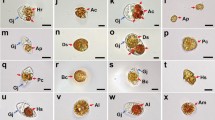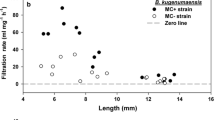Abstract
Bacterivory by heterotrophic nanoflagellates and ciliates has been widely studied in aquatic environments, but data on the grazing of amoebae, are still scarce. From the water samples of Dianchi Lake (Kunming, Yunnan Province, China), we isolated an amoeba, designated as Naegleria sp. strain W2, which had potent grazing effects on some kind of cyanobacteria. The food selection mechanism and the digestion process of the amoeba were investigated in batch experiments. Predation experiments showed that filamentous cyanobacteria (e.g., Anabaena, Cylindrospermum, Gloeotrichia, and Phormidium) were readily consumed, with clearance rates ranging from 0.332 to 0.513 nL amoeba−1 h−1. The tight threads (Oscilltoria) and aggregates (Aphanizomenon) could not be ingested; however, their sonicated fragments were observed inside food vacuoles, suggesting that their morphologies prevent them from being ingested. Live video microscopy noted that unicellular Chroococcaceae (e.g., Synechococcus, Aphanocapsa, and Microcystis) were excreted after ingestion, indicating that food selection takes place inside food vacuoles. To determine whether the tastes or the toxins prevented them from being digested, heat-killed cells were retested for predation. Digestion rates and ingestion rates of the amoebae for filamentous cyanobacteria were estimated from food vacuole content volume. Through a “cold-chase” method, we found that the food vacuole contents declined exponentially in diluted amoebae cells, and digestion rates were relatively constant, averaging about 1.5% food vacuole content min−1 at 28°C. Ingestion strongly depended on the satiation status of the amoebae, starved amoebae fed at higher rates compared with satiated amoebae. Our results suggest that the food selection and food processing mechanisms of the amoeba are similar to those of interception feeding flagellates; however, filamentous cyanobacteria cannot obtain a refuge under the grazing pressure of phagotrophic amoebae, which may widen our knowledge on the grazing of protists.







Similar content being viewed by others
References
Allen, MM (1968) Simple conditions for growth of unicellular blue-green on plates. J Phycol 4: 1–4
Boenigk, J, Arndt, H (2000) Particle handling during interception feeding by four species of heterotrophic nanoflagellates. J Eukaryot Microbiol 47: 350–358
Boenigk, J, Arndt, H (2000) Comparative studies on the feeding behavior of two heterotrophic nanoflagellates: the filter-feeding choannoflagellate Monosiga ovata and the raptorial-feeding kinetoplastid Rhynchomonas nasuta. Aquat Microb Ecol 22: 243–249
Boenigk, J, Matz, AC, Jurgens, K, Arndt, H (2001) Confusing selective feeding with differential digestion in bacterivorous nanoflagellates. J Eukaryot Microbiol 48: 425–432
Boenigk, J, Matz, C, Jurgens, K, Arndt, H (2001) The influence of preculture conditions and food quality on the ingestion and digestion process of three species of heterotrophic nanoflagellates. Microb Ecol 42: 168–176
Boenigk, J, Arndt, H (2002) Bacterivory by heterotrophic flagellates: community structure and feeding strategies. Antonie Van Leeuwenhoek 81: 465–480
Burkholder, JM, Glasgow Jr, HB (1997) Trophic controls on stage transformations of a toxic ambush-predator dinoflagellate. J Eukaryot Microbiol 44: 200–205
Cater, RF (1970) Description of a Naegleria sp. Isolated from two cases of primary amoebic meningo-encephalitis, and of the experimental pathological changes induced by it. J Pathol 100: 217–244
Christaki, U, Courties, C, Karayanni, H, Giannakourou, A, Maravelias, C, Kormas, KA, Lebaron, P (2002) Dynamic characteristics of Prochlorococcus and Synechococcus consumption by bacterivorous nanoflagellates. Microb Ecol 43: 341–352
Chrzanowski, TH, Simek, K (1990) Prey-size selection by freshwater flagellated protozoa. Limnol Oceanogr 35: 1429–1436
Dolan, JR, Coats, DW (1991) Preliminary prey digestion in a predacious estuarine ciliate and the use of digestion data to estimate ingestion. Limnol Oceanogr 36: 558–565
Dolan, JR, Simek, K (1997) Processing of ingested matter in Strombidium sulcatum, a marine ciliate (oligotrichida). Limnol Oceanogr 42: 393–397
Dolan, JR, Simek, K (1998) Ingestion and digestion of an autotrophic picoplankter, Synchococcus, by a heterotrophic nanoflagellate, Bodo saltans. Limnol Oceanogr 43: 1740–1746
Farmer, JN (1980) The Protozoa: Introduction to Protozoology. Mosby. St. Louis, MO
Gonzalez, JM, Iirberri, J, Egea, L, Barcina, I (1990) Differential rates of digestion of bacteria by freshwater and marine phagotrophic protozoa. Appl Environ Microbiol 56: 1851–1857
Gonzalez, JM, Sherr, EB, Sherr, BF (1990) Size-selective grazing on bacteria by natural assemblages of estuarine flagellates and ciliates. Appl Environ Microbiol 56: 583–589
Hahn, MW, Moore, ER, Hofle, MG (1999) Bacterial filament formation, a defense mechanism against flagellate grazing, is growth rate controlled in bacteria of different phyla. Appl Environ Microbiol 65: 25–35
Hahn, MW, Moore, ER, Hofle, MG (2000) Role of microcolony formation in the protistan grazing defense of the aquatic bacterium Pseudomonas sp. Mwh1. Microb Ecol 39: 175–185
Hahn, MW, Hofle, MG (2001) Grazing of protozoa and its effect on populations of aquatic bacteria. FEMS Microbiol Ecol 35: 113–121
Heinbokel, JF (1978) Studies on the functional role of tintinnids in the Southern California bight. I. Grazing and growth rates in laboratory cultures. Mar Biol 47: 117–189
Jungmann, D (1992) Toxic compounds isolated from Microcystis aeruginosa PCC 7806 that are more active to Daphnia than two microcystins. Limnol Oceanogr 37: 1777–1793
Jurgens, K, Matz, C (2002) Predation as a shaping force for the phenotypic and genotypic composition of planktonic bacteria. Antonie Van Leeuwenhoek 81: 413–434
Laybourn-Parry, J, Jones, K, Holdich, JP (1987) Grazing by Mayorella sp. (protozoa: Sarcodina) on cyanobacteria. Funct Ecol 1: 99–104
Lorenzen, M, Batley, G (1988) Chemical speciation and trace element toxicity. Chem Aust 55: 363–366
Marshall, MM, Naumovitz, D, Ortega, Y, Sterling, CR (1997) Waterborne protozoan pathogens. Clin Microbiol Rev 10: 67–85
Matz, C, Jurgens, K (2001) Effects of hydrophobic and electrostatic cell surface properties of bacteria on feeding rates of heterotrophic nanoflagellates. Appl Environ Microbiol 67: 814–820
Matz, C, Boenigk, J, Arndt, H, Jurgens, K (2002) Role of bacterial phenotypic traits in selective feeding of the heterotrophic nanoflagellate Spumella sp. Aquat Microb Ecol 27: 137–148
Matz, C, Jurgens, K (2003) Interaction of nutrient limitation and protozoan grazing determines the phenotypic structure of a bacterial community. Microb Ecol 45: 384–398
Matz, C, Deines, P, Boenigk, J, Arndt, H, Eberl, L, Kjelleberg, S, Jurgens, K (2004) Impact of violacein-producing bacteria on survival and feeding of bacterivorous nanoflagellates. Appl Environ Microbiol 70: 1593–1599
Matz, C, Jurgens, K (2005) High motility reduces grazing mortality of planktonic bacteria. Appl Environ Microbiol 71: 921–929
Pfandl, K, Posch, T, Boenigk, J (2004) Unexpected effects of prey dimensions and morphologies on the size selective feeding by two bacterivorous flagellates (Ochromonas sp. and Spumella sp.). J Eukaryot Microbiol 51: 626–633
Posch, T, Jezbera, J, Vrba, J, Simek, K, Pernthaler, J, Andreatta, S, Sonntag, B (2001) Size selective feeding in Cyclidium glaucoma (ciliophora, scuticociliatida) and its effects on bacterial community structure: a study from a continuous cultivation system. Microb Ecol 42: 217–227
Rohrlack, T, Dittmann, E, Henning, M, Borner, T, Kohl, JG (1999) Role of microcystins in poisoning and food ingestion inhibition of Daphnia galeata caused by the cyanobacterium Microcystis aeruginosa. Appl Environ Microbiol 65: 737–739
Sherr, BF, Sherr, EB, Rassoulzadegan, F (1988) Rates of digestion of bacteria by marine phagotrophic protozoa: temperature dependence. Appl Environ Microbiol 54: 1091–1095
Sigee, DC, Glenn, R, Andrews, EG, Bellinger, RD, Butler, HAS, Hendry, RD (1999) Biological control of cyanobacteria: principles and possibilities. Hydrobiolgia 395–396: 161–172
Simek, K, Vrba, J, Pernthaler, J, Posch, T, Hartman, P, Nedoma, J, Psenner, R (1997) Morphological and compositional shifts in an experimental bacterial community influenced by protists with contrasting feeding modes. Appl Environ Microbiol 36: 587–595
Simek, K, Nedoma, J, Pernthaler, J, Posch, T, Dolan, JR (2002) Altering the balance between bacterial production and protistan bacterivory triggers shifts in freshwater bacterial community composition. Antonie Van Leeuwenhoek 81: 453–463
Suzuki, MT, Rappě, MS (1997) Bacterial diversity among small-subunit rRNA gene clones and cellular isolates from the same seawater sample. Appl Environ Microbiol 63: 983–989
Wiesse, T (1993) Dynamics of autotrophic picoplankton in marine and freshwater ecosystems. Adv Microb Ecol 13: 327–369
Wright, SJ, Redhead, K, Maudsley, H (1981) Acanthamoeba castellanii, a predator of cyanobacteria. J Gen Microbiol 125: 293–300
Wu, QL, Boenigk, J, Hahn, MW (2004) Successful predation of filamentous bacteria by a nanoflagellate challenges current models of flagellate bacterivory. Appl Environ Microbiol 70: 332–339
Yamamoto, Y (1981) Observations on the occurrence of microbial agents which cause lysis of blue-green algae in lake Kasumigaura. Jpn J Limnol 42: 20–27
Author information
Authors and Affiliations
Corresponding author
Rights and permissions
About this article
Cite this article
Xinyao, L., Miao, S., Yonghong, L. et al. Feeding Characteristics of an Amoeba (Lobosea: Naegleria) Grazing Upon Cyanobacteria: Food Selection, Ingestion and Digestion Progress. Microb Ecol 51, 315–325 (2006). https://doi.org/10.1007/s00248-006-9031-2
Received:
Accepted:
Published:
Issue Date:
DOI: https://doi.org/10.1007/s00248-006-9031-2




